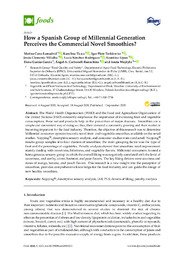Título :
How a Spanish group of millennial generation perceives the commercial novel smoothies? |
Autor :
Cano-Lamadrid, Marina
Tkacz, Karolina 
Turkiewicz, Igor 
Clemente Villalba, Jesús 
Sánchez-Rodríguez, Lucía
Lipan, Leontina
García García, Elena 
Carbonell-Barrachina, Ángel A.
Wojdylo, Aneta |
Editor :
MDPI |
Departamento:
Departamentos de la UMH::Biología Aplicada |
Fecha de publicación:
2020-09-01 |
URI :
https://hdl.handle.net/11000/35224 |
Resumen :
The World Health Organization (WHO) and the Food and Agriculture Organization of
the United Nations (FAO) constantly emphasize the importance of increasing fruit and vegetable
consumption; these natural products help in the prevention of major diseases. Smoothies are a
simple and convenient way of doing so; thus, their demand is constantly growing and their market is
becoming important for the food industry. Therefore, the objective of this research was to determine
Millennial consumer opinion towards novel fruit- and vegetable-smoothies available on the retail
market. Napping®, descriptive sensory analysis, and consumer studies were conducted. Napping®
results group samples into four clusters of smoothies; the main grouping factor was the type of
fruit and the percentage of vegetables. Penalty analysis showed that smoothies need improvement
mainly dealing with sweetness, bitterness, and vegetable flavors. Millennial consumers formed a
homogeneous sensory group in which the overall liking was negatively correlated with the level of
sweetness, and earthy, carrot, beetroot, and pear flavors. The key liking drivers were sourness and
notes of mango, banana, and peach flavors. This research is a new insight into the perception of
smoothies, provides comprehensive knowledge for the food industry, and can guide the design of
new healthy smoothies.
|
Palabras clave/Materias:
Napping®
descriptive sensory analysis
JAR
PLS
drivers of liking
penalty analysis |
Área de conocimiento :
CDU: Ciencias puras y naturales: Biología |
Tipo de documento :
info:eu-repo/semantics/article |
Derechos de acceso:
info:eu-repo/semantics/openAccess
Attribution-NonCommercial-NoDerivatives 4.0 Internacional |
DOI :
10.3390/foods9091213 |
Publicado en:
Foods 2020, 9, 1213; |
Aparece en las colecciones:
Artículos - Biología Aplicada
|
 La licencia se describe como: Atribución-NonComercial-NoDerivada 4.0 Internacional.
La licencia se describe como: Atribución-NonComercial-NoDerivada 4.0 Internacional.
.png)
